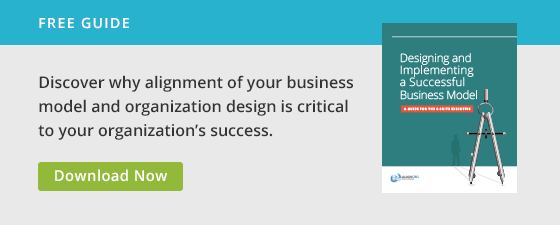There is a practical approach and sequence to alignment when implementing organizational change. It may be tempting to zero in where a problem is surfacing, but by following these steps you can ensure that you align everything from top to bottom (strategy to rewards).
Let’s walk through each step of the organization design and the change management process:
Diagnosis > Strategy > Macro Design > Micro Design > Implementation and Sustainability
Diagnosis: Before you can build a solid house, you need to survey the land and pass your inspections. Skip these steps and your home could be more hazard than habitat. The Diagnosis and Assessment stage in the organization transformation journey is critical. Diagnosis and assessment can give your organization a good handle on where you should start and who you need to involve in addressing misalignments.
- Scope the design initiative.
- Determine the best design approach given the misalignments in your organization.
- Solicit stakeholder feedback to confirm design priorities.
- Schedule working sessions for the Alignment Team.
- Create work session agendas and related materials.
- Confirm Alignment Team member’s participation and engagement.
Strategy: How will your organization win in the marketplace? Consider what assets you have and how you can leverage them for strategic differentiation.
- Know your stakeholders’ requirements and make provisions for them.
- Gain consensus on desired outcomes and factor in criteria for the future design.
- Determine your points of differentiation and strategic trade-offs.
- Design or revise your business model.
- Explore the distinctive capabilities needed to deliver your brand promise (strategy).
Macro Design: Look at the big picture and account for all the resources needed to meet objectives. Once these are determined, how will you group and organize them?
- Design the optimal organizational model.
- Assess the strategic benefits and risks of the design.
- Mitigate the risks of the selected organizational model.
- Define new or changed roles.
- Ascertain high-level staffing implications.
- Determine the areas of the organization to prioritize for micro design in order to implement organizational change.
Note: Between macro and micro design, select new leaders and determine sponsors, project leads, and team members for micro design work streams.
Micro Design: Drill down to the details to examine how the organization will operate after implementing organizational change as well as what capabilities need to be revamped to ensure success.
- Launch micro design teams.
- Assess current performance and where you need to redesign processes.
- Redesign work processes.
- Realign lower levels of the organization, jobs, and spans of control.
- Align performance systems and metrics.
- Review talent impacts.
- Consider how the design changes will enable the right culture.
- Jumpstart implementation planning and communications.
Note: Be methodical. Start the design in the most strategic areas. Then, move onto the next areas until you fully align the organization to strategy and across groups and functions.
Implementation and Sustainability: A blueprint (an organization design) is ineffective if it isn’t implemented effectively and consistently. The focal point during implementation and sustainability is to make sure the organization meets and sustains the benefits of the new design.
- Obtain needed approvals and buy-in.
- Create implementation plans and ensure that you produce new processes, structures, metrics, technologies, and behaviors that will deliver.
- Work with HR to hire and/or redeploy employees as well as conduct training.
- Coordinate communications.
- Evaluate the design impacts and results 6–12 months after implementing organizational change.
Not every organization will follow the implementation and change management process in the same ways but as long as the key steps and principles are built in, success is likely.
Your distinctive implementation process will include a detailed breakdown of tasks. Project management requires a detailed timeline, communications, moving plans, budget/financial planning, equipment logistics, organizational change management, and individual transitions.
In that same vein, people will be a large part of this implementation process. Job creation (descriptions, compensation, grading, success metrics/rewards, etc.) may be a consideration, but you must also think about the hiring (job sourcing and posting, applications, selection, etc.) and transferring (relocations, budgetary and security factors, performance management plans) of employees as well.
Citing a quote from Mastering the Cube, “If the work doesn’t change, the results don’t change.” As mentioned earlier, there’s a tendency to rush the process. Remember, the process of alignment and implementing organizational change is the real work for leadership. That is why you should work with your HR manager or a change partner through every stage.
What’s more, such an intricate, comprehensive design approach and implementation plan emphasizes the importance of the leadership team cascading down to all affected levels. If you don’t ensure that the changes reach the lowest required level within the organization, then you will never meet your business model, organization design, and ultimately your organizational transformation goals.






